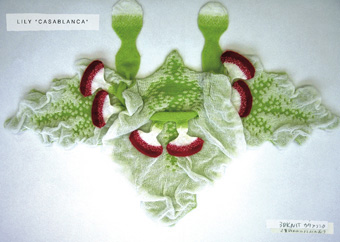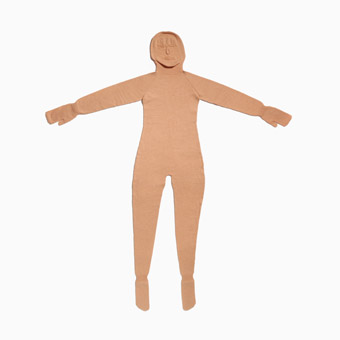the high art of machine knitting
varia karipoff: the endless garment, rmit gallery

Jumper, leggings, hat and gloves no.19 a/w 2008-2009, Walter Van Beirendonck, The Endless Garment
HAVING SHAPED SUCH NOTABLE GRADUATES AS TONI MATICEVSKI, RMIT UNIVERSITY HAS CEMENTED A STELLAR REPUTATION IN DESIGN, PARTICULARLY IN FASHION AND TEXTILES. THE ENDLESS GARMENT EXHIBITION APPEARS UNDER THE PATRONAGE OF THE L’ORÉAL MELBOURNE FASHION FESTIVAL, WHERE THE SHOW CELEBRATES NEW TECHNOLOGY AND THE ORIGINALITY OF DESIGNS. BY TAKING CUTTING-EDGE DESIGNER KNITWEAR OFF THE INTERNATIONAL RUNWAYS AND PLACING IT IN A GALLERY CONTEXT, READY-TO-WEAR APPROACHES SOMETHING AKIN TO HIGH ART.
Items have been sourced from 10 internationally renowned designers and contemporary artists who have employed revolutionary knitting machine technology to delve into new design options. The resulting exhibition is a wonderfully mottled mix tape with moods ranging from the pop-tastic styling of Walter Van Bierendonck, to the gothic and ethereal creations of Nikki Gabriel.
Knitting has come a long way since ‘granny chic’—the young urban movement that popularised handicrafts—usurped the yarn and needles from the Country Women’s Association. Mothball-scented crocheted blankets and doilies of old soon gave way to guerrilla knitters who began to graffiti public items and monuments with knitted street art some five years ago. In the last decade or so, advances in production technology have at once broadened the aesthetic scope for design and taken the artistry of knitting from rocking chair to factory. Curated by Robyn Healy and Ricarda Bigolin, both of RMIT’s Fashion School, the heroes among the high-end designer clothing of this exhibition are the machines that have reinvigorated knitwear design. In the words of the curators, “the exhibition studies the endless design possibilities offered by the new craft of machine knitting to progress design practices from efficiencies of production, fabrication details of surface and texture, to economy of materials.”

Casablanca, lily a/w 2005, Yoshiki Hishinuma, The Endless Garment
The machine process most defiantly steers knitting-craft away from outdated preconceptions. The WholeGarment® machine technology, pioneered by Japanese knitwear machine company Shima Seiki in 1995, has been utilised in the construction of many of the pieces in this exhibition. As its name suggests, the machine knits complete pieces, eliminating the time-consuming and laborious cut and sew process of garment construction. Designers use CAD (Computer Aided Design) to create a garment pattern, which is then saved and transferred to a knitting machine. Picture a sweater as three tubes: the torso, left and right sleeve—these are knitted simultaneously using three carrier yarns with back and front needle beds to create the tube shape. When knitting reaches the underarm seam the tubes are simply connected. Like some implausible machine from Willy Wonka’s factory, the garment emerges whole. A video projection by Antuong Nguyen demonstrates one of the machines at work. Watching the needles looping and bobbing elegantly is strangely enthralling—machinery in the perfect sync of a dance symphony. In a project for her PhD, co-curator Ricarda Brigolin provides an example of the technology with three jumpers knitted as a single connected piece, much like a magician’s handkerchief.
Displayed in a gallery, the pieces take on new life. On runway models at least, lavishly unwearable haute couture is tempered down and humanised. Of the 10 designers showcased, none have that catwalk caw more than Swedish knitwear designer Sandra Bucklund. An immense rippled black jacket is possibly as far from a Paton’s catalogue as you can get. Though like others in the exhibition, Bucklund is new to knitwear production having constructed her prior collections by hand on a made-to-measure basis. Her work distorts the natural silhouette of the body with origami folds and organic textures; her woollen garments here are stately, fit for Queen Armidala. It’s not surprising to see sci-fi get a nod. Recently the Japanese Aerospace Exploration Agency (JAXA) adopted WholeGarment® clothing as daywear for astronauts onboard its spacecraft.
Despite the technology, many of the designs look deceptively handmade. Nikki Gabriel, the other Australian representative in the exhibition and a studio textiles graduate of RMIT, has earned her chops designing for Akira Isogawa and Aurelio Costarello. Her work is intricately dark, almost as though it is spun by hand from a fine silk cobweb.

The Perfect Body, 2007, Freddie Robbins, machine knitted wool, 1920 x 1640 mm, produced through support from the Arts and Humanities Research Council (AHRC) and the Royal College of Art Research Development Fund
photo Douglas Atfield
The Perfect Body, 2007, Freddie Robbins, machine knitted wool, 1920 x 1640 mm, produced through support from the Arts and Humanities Research Council (AHRC) and the Royal College of Art Research Development Fund
Among big name fashion and knitwear designers is a British contemporary artist who uses knitting to explore ideas of domesticity, gender roles and the human condition. Freddie Robin’s life-sized simplified humans with nondescript faces peer from the sexless shadows of their knitted bodies. With titles like The Perfect Body, they explore ideas of standardisation and perfection made possible with what can be called the cold, computer aided technology of the knitting machine.
Across the room is Walter Van Beirendonck, an hirsute Belgian who has designed outfits for U2’s Popmart tour, t-shirts for Australian band The Avalanches, not to mention scores of costumes for theatre, ballet and film. His previous seasons of commercial street wear have a kooky graphic sensibility (his own distinctively bearded image often features while other t-shirts are emblazoned with statements like SEX CLOWN). His knitwear for men bears traces of the chunky brightness of his love for pop music which he has sampled with left of field ethnic and nomad references. Meanwhile, the trio behind rising London label Sibling give men’s knitwear a progressive tweak with gender challenging twists: twinsets are covered in bright leopard spot sequins, ‘Crosby’ cardies are adorned with pink glittering rats and their Breton sweater has a skull cleverly woven into the famous French horizontal lines.
Although the method of production is the unifying element between the ten very different artists, the machine process is often used in a way that hides evidence of itself. Displays detailing the technology unobtrusively inform the viewer of the process that allows for such extraordinary singularity and potential in the hands of designers and artists. Yoshiki Hishinuma’s garments often straddle distinctions between contemporary art, construction experiment and fashion. His Casablanca, lily a/w 2005, a peculiar green-tinged shawl most closely resembles a rare orchid from a Florida swamp or an art installation.
Issey Miyake’s A-POC project (t-shirts rolled out of a fabric baguette—that’s all I will say) must be seen to be believed, while fresh designs by Mark Fast, Cooperative Design and Italian designer, Saveiro Palatella complete the show.
The Endless Garment: The New Craft of Machine Knitting, curators Robyn Healy, Ricarda Bigolin, designers and artists Issey Miyake, Sandra Backlund, Walter Van Beirendonck, Cooperative Designs, Mark Fast, Nikki Gabriel, Yoshiki Hishinuma, Saverio Palatella, Freddie Robins, Sibling; RMIT Gallery, Melbourne, Feb 12-March 21
Orginially published in the March 1, 2010 online edition
RealTime issue #96 April-May 2010 pg. 46






